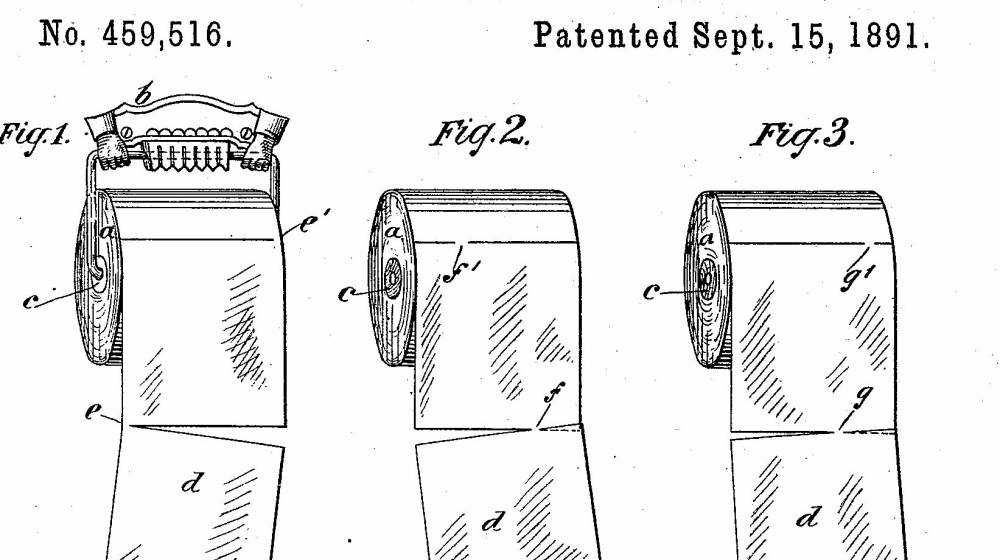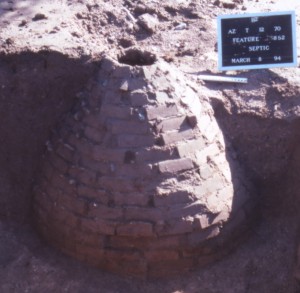The Sewer System in Early Phoenix
Posted July 23, 2014
Written by Lindsey Vogel-Teeter, Museum Curator
One of the questions we get asked on tours is where did the Rosson House get water from and where did waste water go? To be honest, we can’t be 100% certain of the answers to either of those questions. We know the basics of the early water and sewage system in Phoenix, but we don’t know when every house received water and sewage service. In fact, archaeological excavations are one of the best ways to learn details about water supply and sewage systems.
Here at Heritage Square, a minor archaeological survey was done during the 1970s. However, this was a surface survey with very little documentation. Some photos from the survey indicate the possibility of a well on Block 14, but none of the images or notes record exactly where the well was located.
Archaeological excavations of Block 13 (now underneath the Heritage Parking Garage) did not find evidence of a sewer line dating
to the 1890s. In fact, those excavations showed that residents used septic tanks and outhouses into the 1900s. In addition, multiple wells were found (dating up to the 1910s), suggest that people living in Block 13 were not on the early water supply system either. The high cost of purchasing and installing pipes may have been a deterrent for connecting to service systems.
Here’s what we do know about water services in early Phoenix. The Phoenix Water Works Company was started in 1889. It was a private venture which pumped water from wells and later from the Verde River. The first supply pipes were located in the Dennis Addition (bounded by 7th, 12th, Van Buren, and Roosevelt streets). The City took over the water system in 1907. Likewise, the first sewer system was also a private venture. Starting in 1892, the main sewer pipe ran down Center Street (Central) and dumped into the Salt River. However, by the early 1900s less than 10% of the City had sewer service. Phoenix took over the sewer system in 1911 and required households to connect to the sewer system by 1915.
With the amenities of the Rosson House and its location close to the water works, it’s certainly possible that the house was built with a connection to the water and sewage system. However, without definitive evidence it’s also possible that the house had water pumped from an on-site well and used a brick septic tank.
To learn more about water and sanitation in early Phoenix check out these resources, some of which are available in the docent library and staff office – Mark Hackbarth, The Historic Archaeology of Heritage Square, 1995; Philip VanderMeer, Desert Visions and the Making of Phoenix, 2010; J. Homer Thiel, “Sanitation in Turn-of-the-Century Phoenix” in Phoenix’s Hidden History, 1998; Geoffrey Mawn, “Phoenix, Arizona: Central City of the Southwest, 1870-1920”, 1979 (Ph.D. dissertation available at ASU).
Learn more about the history of plumbing from our May 2021 blog article, Down the Drain.
Archive
-
2024
-
July (1)
-
June (1)
-
May (1)
-
April (1)
-
March (1)
-
February (1)
-
January (1)
-
-
2023
-
December (1)
-
November (1)
-
October (1)
-
September (1)
-
August (1)
-
July (1)
-
June (1)
-
May (1)
-
April (1)
-
March (1)
-
February (1)
-
January (1)
-
-
2022
-
December (1)
-
November (1)
-
October (1)
-
September (1)
-
August (1)
-
July (1)
-
June (1)
-
May (1)
-
April (1)
-
-
2021
-
December (1)
-
November (1)
-
October (1)
-
September (1)
-
August (1)
-
July (1)
-
June (1)
-
May (1)
-
April (1)
-
March (1)
-
February (1)
-
January (1)
-
-
2020
-
December (1)
-
November (1)
-
October (1)
-
September (1)
-
August (1)
-
July (1)
-
June (1)
-
May (1)
-
April (1)
-
March (1)
-
February (1)
-
January (1)
-
-
2019
-
December (1)
-
November (1)
-
October (1)
-
September (1)
-
August (1)
-
July (1)
-
June (1)
-
May (1)
-
April (1)
-
March (1)
-
February (1)
-
January (1)
-
-
2018
-
December (1)
-
November (1)
-
October (1)
-
September (1)
-
August (1)
-
July (1)
-
May (1)
-
April (1)
-
March (1)
-
February (1)
-
January (1)
-
-
2017
-
December (1)
-
November (1)
-
October (1)
-
September (1)
-
August (1)
-
July (1)
-
June (1)
-
May (1)
-
April (1)
-
March (1)
-
February (1)
-
January (1)
-
-
2016
-
December (1)
-
-
2015
-
2014
-
July (1)
-

